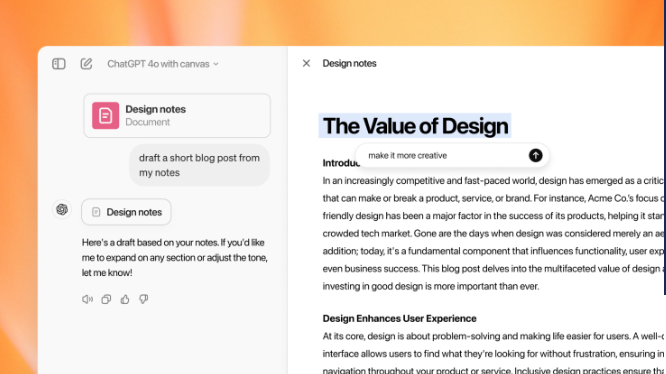OpenAI announced that Canvas, the much-anticipated ChatGPT sidebar editing tool, is officially open to all users! Previously, the Canvas function was only available to paid subscribers. This update has greatly improved the usability and convenience of ChatGPT. Canvas allows users to edit text and code in an independent sidebar while chatting in ChatGPT, and view the modification results in real time, significantly improving work efficiency. This update not only brings a smoother user experience, but also provides more powerful tools for developers and data analysts.
OpenAI announced during its "12Days of OpenAI" live broadcast series that it has expanded its side digital editing space Canvas to all ChatGPT users and added a series of new features. Canvas was originally released in October and was previously limited to paid users, including ChatGPT Plus, Teams, Edu and Enterprise subscribers.

The design of Canvas changes the traditional interface of ChatGPT, placing the dialog box at the top of the page, and adding a content editing area on the right side of the page, where users can write code blocks or text files.
When a user has a conversation with ChatGPT and requests modifications to the content in the right sidebar, the system will automatically present the modification results in the sidebar instead of generating a new text reply. Not only does this improve productivity, it also allows Canvas to provide instant text and code suggestions.
Now that Canvas is integrated with the GPT-4o version, users no longer need to switch to GPT-4o to use Canvas. Certain prompts or pasted text such as "Use Canvas..." will automatically open Canvas and are currently only available in the Web version and Windows application.
This update enables Canvas to run Python code, support more text pasting, and can be launched in a custom GPT. Users can now paste Python code directly into ChatGPT and the system will automatically open Canvas, which means users no longer need to manually copy the code and run it on their own system. Canvas can also automatically generate and preview graphics based on code, making it easier for developers and analysts to adjust formulas or data. Additionally, Canvas has the ability to find coding errors and suggest corrections.
For custom GPT users, Canvas is integrated by default, but users can define when and whether to open Canvas in the assistants they create. For existing custom GPTs, OpenAI has not set Canvas as the default function to avoid affecting the use of these assistants. However, users can add Canvas as a feature by customizing GPT's settings.
OpenAI stated that it will continue to improve Canvas and launch more new features in the future. Canvas and similar features are a microcosm of the interface competition that current chat platform model makers face as users seek more useful features.
Highlight:
? OpenAI announced that it will extend the Canvas function to all ChatGPT users, improving the user editing experience.
? Canvas newly supports Python code running, and users can view and edit code effects directly on the platform.
?️ Customized GPT integrates Canvas by default, and users can freely set usage parameters to enhance personalized functions.
The full opening of Canvas this time marks an important step for OpenAI in improving user experience. In the future, we will look forward to Canvas bringing more surprises and innovative features to provide users with a more convenient and efficient AI interactive experience.